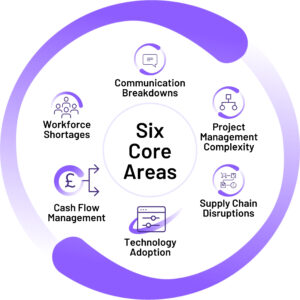Top Challenges in Modern Construction Operations
Construction operations face a labour shortage that demands 439,000 new workers in 2025 alone. This shortage sits alongside material price volatility that's pushed costs up 30-40% in recent years. These aren't separate problems you can tackle individually, they connect in ways that can only become manageable with the right approach. Most construction professionals know about these challenges but struggle to understand how they link together and what practical steps actually work.
This guide breaks down the six core areas where construction operations hit roadblocks and shows you proven solutions that address root causes rather than symptoms. The strategies come from real project data and industry analysis, focusing on what you can implement immediately.

1. Workforce Shortages: The Skills Crisis That's Reshaping Construction
The challenges in the construction industry run deeper than simply needing more bodies on site. You're facing a perfect storm where 41% of experienced workers retire by 2031, taking decades of practical knowledge with them.
The numbers tell the story. The median worker age has hit 42 and younger people aren't entering trades fast enough to fill the positions. This creates immediate impacts on every project you run.
The Real Cost of Labor Shortage on Your Operations
- Project timelines stretch longer because skilled labour simply isn't available when you need it.
- Quality drops when overworked teams rush to meet impossible deadlines.
- Safety incidents increase without experienced workers providing guidance to newcomers.
- Resource planning becomes unpredictable as labour availability fluctuates week to week.
Practical Steps to Build Your Workforce Pipeline
Start with actions you can implement immediately:
- Offer digital payment systems that appeal to younger workers.
- Create clear progression paths from apprentice to senior roles.
- Partner with local colleges for guaranteed placement programmes.
- Cross-train existing workers on multiple skills.
For long-term success:
- Document processes before experienced workers leave.
- Build relationships with reliable staffing agencies.
- Implement mentoring programmes pairing veterans with newcomers.
- Invest in competitive benefits including health insurance and pensions.
2. Communication Breakdowns: The Hidden Profit Drain
Poor communication creates the most expensive problems in construction operations. When information doesn't flow properly between teams, small issues become costly challenges that reduce your already thin margins.
Communication failures typically show up as information gaps between field and office teams, delayed change notifications and inconsistent documentation.
How Communication Problems Impact Your Bottom Line
- Rework costs when teams receive unclear or outdated information.
- Project delays when critical decisions wait for missing information.
- Disputes arise from undocumented agreements or scope changes.
- Safety incidents occur due to inadequate hazard communication.
Building Reliable Communication Systems
Daily protocols that work:
- Run 15-minute morning stand-ups with key stakeholders.
- Use standardised reporting templates for consistency.
- Implement escalation procedures for urgent issues.
- Create visual dashboards showing real-time project status.
Technology that supports field teams:
- Deploy mobile apps with offline capability for reliable field use.
- Use cloud-based document sharing with automatic version control.
- Enable photo and video messaging for clear visual communication.
- Implement digital markup tools for plans and specifications.
3. Project Management Complexity: Controlling Multiple Moving Parts
Project management in construction means juggling budget, schedule and quality whilst external factors constantly shift the rules. With industry profit margins averaging just 6%, there's no buffer for poor planning or execution.
Budget Control: Protecting Your Margins
Budget overruns affect 98% of construction projects, with average increases of 20-30%. Material price volatility makes accurate budgeting nearly impossible when prices swing 15-20% during a project's lifecycle.
Primary budget threats:
- Material costs changing between estimate and purchase.
- Change orders processed without full cost analysis.
- Poor initial estimates based on incomplete information.
Proven budget protection strategies:
- Build 10-15% contingency reserves based on project complexity.
- Use escalation clauses for materials with volatile pricing.
- Validate estimates with current quotes from multiple suppliers.
- Implement weekly cost reviews comparing actual vs budgeted expenses.
Time Management: Preventing Cascading Delays
Time management failures create cascading effects where early delays compress later activities. This requires teams to work under pressure and often leads to quality compromises or safety shortcuts.
Common delay causes:
- Weather impacts without adequate buffer time.
- Equipment breakdowns without backup plans.
- Subcontractor coordination failures.
- Permit delays from incomplete documentation.
Effective scheduling solutions:
- Build weather contingency based on historical regional data.
- Create resource-levelled schedules preventing activity conflicts.
- Conduct weekly look-ahead planning to spot problems early.
Managing Scope Changes: Protecting Profitability
Scope changes reduce profitability through gradual work expansion without budget adjustments. Individual changes seem minor, but their cumulative effect eliminates profit margins entirely.
The problem starts with verbal requests for "small additions" that aren't properly documented or priced.
Scope change warning signs:
- Verbal requests for work not in original specifications.
- Client expectations exceeding documented requirements.
- Design changes discussed without written confirmation.
- Additional work performed before change orders are signed.
Change management process:
- Define project scope precisely in initial contracts.
- Document all verbal communications within 24 hours.
- Require written approval before beginning additional work.
- Present change orders with clear cost and schedule implications.
4. Supply Chain Disruptions: Managing Material Volatility
Supply chain problems have shifted from occasional disruptions to persistent management challenges. Material shortages, transport challenges in the construction industry and price volatility now require ongoing attention.
Global economic factors including trade disputes, inflation and currency fluctuations create material price swings that eliminate profit margins on fixed-price contracts.
The Real Impact on Your Operations
- Material shortages cause delays when alternatives aren't available.
- Price increases occur between contract signing and purchase.
- Quality issues emerge when forced to use unfamiliar suppliers.
- Transport delays affect just-in-time delivery schedules.
Building Supply Chain Resilience
Supplier diversification:
- Develop relationships with multiple suppliers for critical materials.
- Research local sourcing options to reduce transport dependencies.
- Evaluate supplier financial stability before commitments.
- Negotiate flexible pricing terms for volatile materials.
Strategic procurement:
- Implement strategic stockpiling for unpredictable materials.
- Use purchase orders with price escalation clauses.
- Monitor usage patterns to improve demand forecasting.
- Create approved vendor lists with pre-negotiated pricing.
5. Technology Adoption: Bridging the Digital Gap
Construction technology adoption lags other industries due to budget constraints, workforce resistance and system compatibility challenges. However, digital transformation offers significant opportunities for addressing labour shortages and improving productivity.
Limited budgets from thin margins, resistance to changing established workflows and lack of technical expertise create barriers to implementation.
Overcoming Technology Barriers
Common adoption challenges:
- Budget constraints limiting technology investment.
- Workforce resistance to changing familiar processes.
- System compatibility issues creating data silos.
- Lack of technical expertise for implementation.
Strategic implementation approach:
- Start with pilot programmes demonstrating clear ROI.
- Focus on technologies with measurable returns.
- Provide comprehensive training ensuring adoption.
- Select unified platforms rather than fragmented solutions.
Priority Technology Areas
- Building Information Modelling (BIM) for design coordination and clash detection before construction begins.
- Project management platforms unify scheduling, budgeting and communication in one system.
- Mobile applications enabling field teams to access and update project information in real-time.
- IoT sensors for equipment monitoring and predictive maintenance reduce downtime.
6. Cash Flow Management: Maintaining Financial Stability
Cash flow challenges in construction stem from project-based revenue cycles, delayed payments and upfront material costs. Poor cash flow management can threaten business survival even when projects are profitable on paper.
The construction industry's payment cycles create natural cash flow gaps. You often pay suppliers and workers before receiving payment from clients, creating funding gaps that can last months.
Cash Flow Risk Factors
- Payment delays from clients extending beyond contract terms.
- Material cost escalation requiring additional funding mid-project.
- Change order disputes delaying payment for completed work.
Practical Cash Flow Solutions
Payment acceleration strategies:
- Negotiate shorter payment terms in contracts.
- Offer early payment discounts to clients.
- Use invoice factoring for immediate cash conversion.
- Implement progress billing tied to specific milestones.
Working capital management:
- Maintain credit facilities for seasonal fluctuations.
- Monitor accounts receivable aging closely.
- Establish payment milestone schedules aligned with cash needs.
- Use construction-specific accounting software for accurate projections.
Unified Solutions for Construction Operations Challenges
These construction operations challenges interconnect in ways that require unified solutions rather than isolated fixes. Labour shortages increase costs and extend schedules, creating pressure that increases safety risks. Poor communication amplifies every challenge by preventing early problem identification.
Understanding these connections enables more effective resource allocation and problem-solving approaches.
Challenge Interconnections
- Workforce shortages create productivity pressure, increasing safety risks.
- Financial constraints limit technology investments that could solve operational problems.
- Communication failures amplify impacts of scope changes and scheduling delays.
- External factors make internal operational challenges more difficult to manage.
Implementation Framework
Foundation Phase (Months 1-6):
- Establish safety protocols and training programmes.
- Implement communication systems and standardised procedures.
- Deploy financial tracking and control systems.
- Begin workforce development initiatives.
System Unification Phase (Months 6-18):
- Deploy unified project management platforms.
- Expand technology adoption based on pilot results.
- Develop comprehensive risk assessment procedures.
- Build diversified supplier relationships.
Optimisation Phase (Months 18+):
- Refine processes based on operational data.
- Scale successful programmes across all projects.
- Develop advanced technology capabilities.
- Build organisational resilience for future challenges.
Moving Forward: Building Resilient Construction Operations
The construction industry adapts continuously to changing conditions. Companies approaching these challenges systematically with unified solutions position themselves for long-term success regardless of external pressures.
Success comes from recognising that construction operations challenges connect to each other. Solutions must address root causes rather than symptoms.
Start with the foundation elements - safety, communication and financial controls. These create the platform for tackling more complex operational challenges like technology adoption and supply chain optimisation.
Your next step is choosing which challenge area needs immediate attention in your operations. Focus on the area causing the most disruption to your current projects, then build from there using the interconnected approach outlined above. Xpedeon ERP is here to help you overcome all such challenges, see it for yourself and Book a Demo Today!
